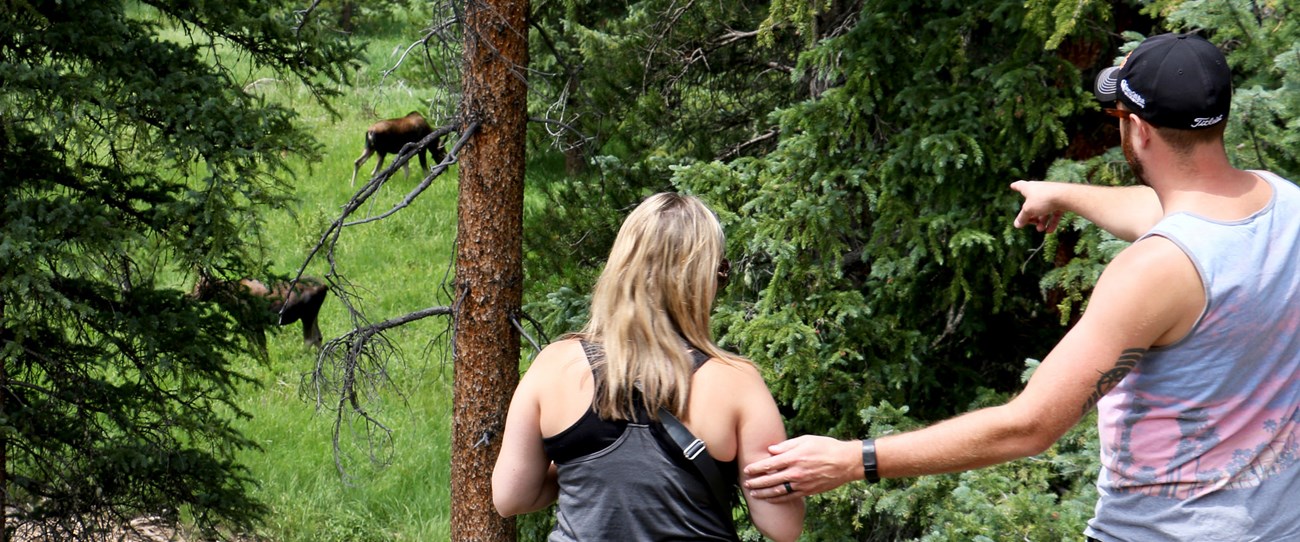
NPS Photo / M. Reed
You can help keep yourself and other visitors safe and wildlife wild by setting a good example! Remember to treat wildlife with proper caution and respect. The safety of these animals, as well as your safety, depends on everyone using good judgment and following these simple guidelines. Learn even more ways to #RecreateResponsibly.
1. Know before you go. Every park is unique and has specific guidelines, including minimum wildlife viewing distances and food storage requirements. Before you head out on the trail, take a few minutes to review the park’s rules.
2. Give animals room. The best way to stay safe when watching wildlife is to give animals room to move. Many parks require you to stay a minimum distance of 25 yards from most wildlife and 100 yards from predators like bears and wolves. (Check with your park: for example, Olympic National Park requires a minimum distance of 50 yards.) Parks provide a unique opportunity to view animals’ natural behavior in the wild. In general, if animals react to your presence you are too close. If you’re close enough for a selfie, you’re definitely too close. Use binoculars or a zoom lens and move back if wildlife approach you. Let wildlife be wild and observe from a distance.
2. Give animals room. The best way to stay safe when watching wildlife is to give animals room to move. Many parks require you to stay a minimum distance of 25 yards from most wildlife and 100 yards from predators like bears and wolves. (Check with your park: for example, Olympic National Park requires a minimum distance of 50 yards.) Parks provide a unique opportunity to view animals’ natural behavior in the wild. In general, if animals react to your presence you are too close. If you’re close enough for a selfie, you’re definitely too close. Use binoculars or a zoom lens and move back if wildlife approach you. Let wildlife be wild and observe from a distance.
3. Do not disturb. Even when you’re farther away, leaving wildlife alone can help your viewing experience—plus it’s the law. It’s illegal to feed, touch, tease, frighten, or intentionally disturb wildlife. Remember that wildlife in parks are wild and can be unpredictable when they’re disturbed or surprised. Interacting with wildlife also can cause harm to both people and wildlife, including injury and disease. Stay on trails to help keep human presence in predictable areas. If dogs are allowed, keep them on-leash (most parks have a 6-foot leash policy) pick up fecal matter and ensure they are vaccinated, and do not use bird calls or wildlife calls and attractants.
4. Keep your eyes on the road. Vehicle strikes are one of the most deadly types of encounters for wildlife in parks. Roads cut through their habitats or migration routes. Be sure to always follow the speed limits and watch for wildlife that may dart into the road. When you want to stop to watch wildlife, pull your vehicle completely off of the road into a designated pull-out—this keeps wildlife safe as well as other motorists.
4. Keep your eyes on the road. Vehicle strikes are one of the most deadly types of encounters for wildlife in parks. Roads cut through their habitats or migration routes. Be sure to always follow the speed limits and watch for wildlife that may dart into the road. When you want to stop to watch wildlife, pull your vehicle completely off of the road into a designated pull-out—this keeps wildlife safe as well as other motorists.
5. Store your food and stash your trash. Feeding wildlife in parks can make them come looking for more. To an animal, anything that smells like food is treated like food. Access to trash, and even crumbs left on picnic tables can attract them. Once they have learned that people are a source of food, wildlife can become aggressive toward people. This puts you at risk of injury and the wildlife at risk of being removed and humanely killed by wildlife managers. Don’t be responsible for the death of wildlife! Keep a clean picnic area or campsite, and store your food and dispose of garbage in the proper containers. Use wildlife-resistant food storage or trash containers where available or required and make sure they’re securely closed.
6. See something, say something. Tell a ranger if you come into physical contact with wildlife. Also, tell a ranger if you see wildlife that are sick, dead, or acting strangely, including wildlife that approach you. And when you see people who aren’t following these guidelines, let them know what they can do to be a smart wildlife watcher, too, and contact a ranger if necessary.
7. Be responsible. Ultimately, staying safe and keeping wildlife wild is up to you! When you go out into a national park, it’s your responsibility to keep yourself, your family, and the wildlife safe.
7. Be responsible. Ultimately, staying safe and keeping wildlife wild is up to you! When you go out into a national park, it’s your responsibility to keep yourself, your family, and the wildlife safe.
Last updated: November 24, 2020
